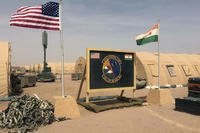The American who committed the deadliest mass shooting on a US military base experienced personal setbacks before becoming an Islamic extremist with "a suicide wish," his cousin said.
Nader Hasan, an attorney who lives with his family in Virginia, said he and Nidal Hasan, the former Army major and psychiatrist convicted of killing 13 people and injuring 42 others in a 2009 mass shooting at Fort Hood, Texas, grew up like brothers a few hours from Washington, D.C.
Nader said he never saw any signs that his cousin would commit such violence. He said as a child, Nidal refused to break up fights involving the cousins and as an adult, his discomfort at the sight of blood was one of the reasons he went into psychiatry after medical school.
"I never saw it coming," he said.
Related Video:
But in hindsight, Nader said, there were clues. Nidal lost both of his parents in a short period of time, he heard stories of possible war crimes from soldiers in his care at Walter Reed Army Medical Center -- confessions his bosses told him to ignore -- and he was so conflicted at the prospect of deploying to a combat zone that he offered to repay his commission and leave the service, Nader said.
"You never really know why" someone commits such a crime, he said. "You just never do. You can speculate all day long. I just never want to sound like I am in any way trying to justify" what happened, he added. "That's the hardest thing. It's a hard thing just to talk about it."
His comments came at the Motion Picture Association of America in Washington, D.C., after a recent screening of a new HBO documentary, "Homegrown: The Counter-Terror Dilemma," which explores the threat posed by homegrown Islamic extremism.
The film, set to premiere 9 p.m. Monday on the cable channel, is directed by Greg Barker and draws from a new book, "United States of Jihad," by Peter Bergen, a New York Times bestselling author, CNN national security analyst and professor at Arizona State University.
The two previously collaborated on the 2013 documentary, "Manhunt: The Search for bin Laden," based on Berger's bestseller, "Manhunt: The Ten-Year Search for Bin Laden From 9/11 to Abbottabad," about the al-Qaida leader Osama bin Laden who was killed by Navy SEALs during a raid on his compound in Pakistan in 2011.
"In many ways, this is a follow up to that," Barker said.
Coincidentally, the documentary's release comes as President Barack Obama has sought to improve the relationship between American Muslims and their fellow citizens by making his first visit to a US mosque.
"If you're ever wondering whether you fit in here, let me say it as clearly as I can, as president of the United States: You fit in here -- right here," he said on Wednesday at the Islamic Society of Baltimore. "You're right where you belong. You're part of America, too. You're not Muslim or American. You're Muslim and American."
The HBO documentary features interviews with Nader Hasan and Phil Mudd, the former deputy director of the FBI's national security branch who investigated Ehsanul Islam Sadequee, then a 23-year-old from Roswell, Georgia, who in 2009 was sentenced to serve 17 years in prison for conspiring to provide material support to terrorists plotting to strike targets in Washington, D.C.
After the screening, Bergen moderated a panel that included Barker, Mudd and Hasan.
When asked by a member of the audience on what leads an American citizen down the path of violent extremism, Barker said each case is different. "Why does someone join a gang?" he asked. "It's [because of] family pressures, family issues, adolescence ... it's very hard to speculate."
Mudd, who in a dramatic moment in the film invites Sadequee's mother and sisters into his home to discuss the case, said the issue has more to do with cults than religions.
"You might think of it as a cult culture instead of a religious phenomenon," he said. "The Columbine kids were part of their own personal cult culture and they committed an act of violence together that I'm not sure they would have committee alone without that socialization," he said, referring to the 1999 mass shooting at Columbine High School in Colorado in which two seniors, Eric Harris and Dylan Klebold, murdered 12 students and a teacher.
"When I talk to a terrorist in Saudi Arabia or this kid in Atlanta, there's a cult aspect to this," Mudd said. "We tend to cookie-cutter this in the US and say this is Islamic terrorism and I think that's way too simplistic. The characteristics that I witnessed are multi-dimensional. They're not somebody who reads the Koran and says, 'I'm going to go out and shoot someone.'"
In the months leading up to the Fort Hood shooting, Nidal Hasan communicated with Anwar al-Awlaki, a US-born radical Islamic cleric, according to a 2012 government investigation into the incident. (Al-Awlaki was killed in 2011 by a US MQ-1 Predator drone strike in Yemen.)
On Nov. 5, 2009, the day of the shooting, Hasan entered the Fort Hood deployment center carrying two pistols, jumped on a desk and shouted "Allahu Akbar!" -- Arabic for "God is great" -- then opened fire, killing 12 US soldiers, one civilian employee and injuring 42 others, according to the report.
Hasan was shot by an officer who responded to the scene, paralyzing him from the waist down. He's currently imprisoned at Fort Leavenworth, Kansas, awaiting a death sentence. He may never be executed, however, as the appeals process is long and the US military hasn't actually carried out an execution since 1961.
It's unclear when exactly Hasan became radicalized. In one surreal moment in the documentary, Hasan is shown in a homemade video giving a presentation at Walter Reed in which he seems to suggest that Muslims in the military should be more closely scrutinized for extremist beliefs.
His cousin said he hadn't seen that video until he watched the documentary. Nader said he hadn't seen or spoken to Nidal since 2007. They had a falling out after Nidal criticized him for bringing a female date to a family Thanksgiving gathering "who wasn't represented by a man," Nader said. In some Islamic cultures, women aren't permitted to leave the house without being accompanied by a male relative.
Even so, after reading portions of the reported 18 emails Nidal exchanged with al-Awlaki, Nader said he would have had a tough time trying to decipher whether Nidal was actually an extremist preparing to commit violence.
"If I were the agent, I couldn't have been able to ... say he is ready to do something at that time because he was smart -- he's a doctor, he's a psychiatrist -- he was able to weave his own sense of the right thing," Nader said.
Soft-spoken and articulate, Nader described himself as a secular Muslim and patriotic American. Growing up in the 1980s, he recalled the Soviet Union being the enemy. "It was Rocky and Drago," he said, referring to Ivan Drago, the fictional character and nemesis from the 1985 film, "Rocky IV." "That was the big thing. That was the Evil Empire -- that and Darth Vader."
Nader said he had a different childhood experience than Nidal in part because his parents were divorced. Nader said he and his siblings excelled academically despite living in a single-parent household -- a point of friction between the cousins.
"There was a competition with him and his brother ... that his parents would put into them and say, 'Look at what these guys are doing and they don't have a father,'" he said. "So his brother became a lawyer and Nidal actually became a doctor."
In college, Nidal would drop classes if he wasn't going to get an A to maintain a high GPA, which he knew was important to his parents, Nader said. "You start seeing how much making his parents happy was the focus of his life and he loses both of them within three years," he said.
Nidal's mother died of cancer in May 2001, three years after his father passed away, Nader said. After the 9/11 terrorist attacks, Nidal experienced "his first challenge" as a Muslim in the military with a name that sounded like Saddam Hussein, Nader said. "We started hearing stories that when he would go on Reserve duty that there would be some form of harassment," he said.
But the "precipitating event" for Nidal was probably the prospect of having to deploy to Afghanistan, Nader said. The shooting occurred just weeks before he was scheduled to ship out. "It was evident to us that he didn't want to go to war," Nader said. "He was starting to talk about conscientious objector status. How far it went I didn't know until after the fact. He actually hired a lawyer."
Ultimately, Nidal was "selfish" and harbored "a suicide wish," Nader said. "In all extremism, there's a superiority complex at some point that's taken on where you know you're right and you have this exclusivity to this heaven or this afterlife."
Since the shooting, Nader teamed with Kerry Cahill, the daughter of Michael Cahill, who was killed in the Fort Hood attack, to travel around the US and speak out against extremism. He also set up a foundation to create "a safe space" for young Muslim Americans to talk about religious and secular issues.
"I think the platform of non-violence and patriotism -- that there's no conflict between being Muslim and American -- is the first step," he said.
--Brendan McGarry can be reached at brendan.mcgarry@military.com. Follow him on Twitter at @Brendan_McGarry.




























